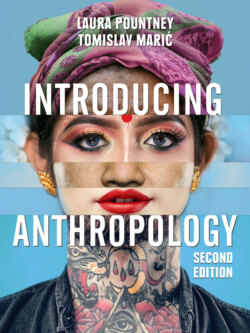Читать книгу Introducing Anthropology - Laura Pountney - Страница 95
Digital Anthropology
ОглавлениеDigital anthropology is the anthropological study of the relationship between humans and the digital era technology. This field is new in anthropology and has different names – such as digital ethnography, social media ethnography, cyber anthropology or virtual anthropology. (Throughout this book there are references to digital anthropology; for example, see Chapter 11.) Since this is a new area in anthropology, it is necessary to take a different approach to research methods. A number of anthropologists have conducted traditional ethnographies of virtual worlds (see, for example Nardi 2010 and Boellstorff 2015 – see Chapter 11). Anthropologist Daniel Miller has carried out many ethnographies of different social media (see p. 111) and Gabriella Coleman (2014) has done ethnographic studies on anonymous hacktivist networks. Digital anthropologists who study online communities use traditional methods of fieldwork. They participate in online communities in order to learn about their cultural practices as well as conducting interviews and using quantitative data. The case study that follows, and the interviews with Sarah Pink and Crystal Abidin, give us some insight into the implications of the ethnographic approach to the digital world for anthropological research practice.
digital anthropology The anthropological study of relationship between humans and the digital era technology
social media ethnography Ethnography that engages with internet practices and content directly, but not exclusively
Social media and digital technologies are involved in countless aspects of social life for people around the globe, with different apps and platforms associated with different social activities or groups. (© pressureUA / iStock )
The anthropology of smartphones and smart ageing
This multi-sited research project, run by Daniel Miller and based at University College London, is funded primarily by the European Research Council. The project includes a team of eleven anthropologists conducting simultaneous sixteen-month-long studies in Ireland, Italy, Cameroon, Uganda, Brazil, Chile, Al-Quds (East Jerusalem), China and Japan. Launched in October 2017, with fieldwork beginning in February 2018, this collaborative five-year project examines the experience of ageing for people at mid-life – that is, those who consider themselves neither still young nor yet elderly. Its aim is to research their use of smartphones and what that teaches us about the contemporary digital world. The intention is to use these ethnographies to help develop the use of smartphones in a way that will be beneficial to people’s health and welfare so that they can become helpful at a time of life when ill-health often starts to result in a loss of capacities.
At first, the project aimed to facilitate mobile health initiatives, which mainly consist of bespoke smartphone apps aimed at helping people to deal with sickness, disease and frailty. But in the process of carrying out research, the team realized that, for health purposes, people make far more use of everyday apps such as WhatsApp and Google. They therefore switched their focus to learning from the ways in which people had adapted those apps for health purposes and, in turn, to informing health professionals how they could benefit. So a top-down focus was replaced by something the project calls smart-from-below.
Social media platforms and digital technologies are increasingly used for health purposes. (© Daniel Miller)
This is an excellent example of research that combines the intellectual challenge of understanding the impact of new media on the contemporary nature of ageing with an applied challenge to use this knowledge to help make smartphones more effective in the field of health. Both the intellectual and the applied challenges depend upon sensitivity to the forms of cultural diversity uncovered by the comparative ethnographic approach.
The research will lead to a series of open access monographs and collaborative volumes, aimed at both anthropological and wider audiences alike. The findings will be shared on a website, in films, and through accessible teaching materials. Early findings (2020) suggest that:
The smartphone is not just a youth technology. In fact, the research finds that older people with mobility issues, for example, see smartphones as more central to their lives than do some young people
The smartphone is not just a device that is used, but a place that we live, which is really important in a sometimes rootless and restless world. The smartphone is the place that we can come back to at a second’s notice
The smartphone has become a vehicle for the provision of care. There is also a fine line between care and surveillance.
The new characteristic of ‘old age’ is frailty. People who expected to become elderly actually don’t feel any different, so they never come to see themselves as old. This continues until they experience ill-health and frailty.
The smartphone achieves a new intimacy that feels like an expression and extension of the person, and, being always present, creates a kind of perpetual opportunism, taking pictures, making notes, providing entertainment and enabling contact with others at any time.
STOP & THINK
What are the implications of the ethnographic approach to the digital world for anthropological research practice?
